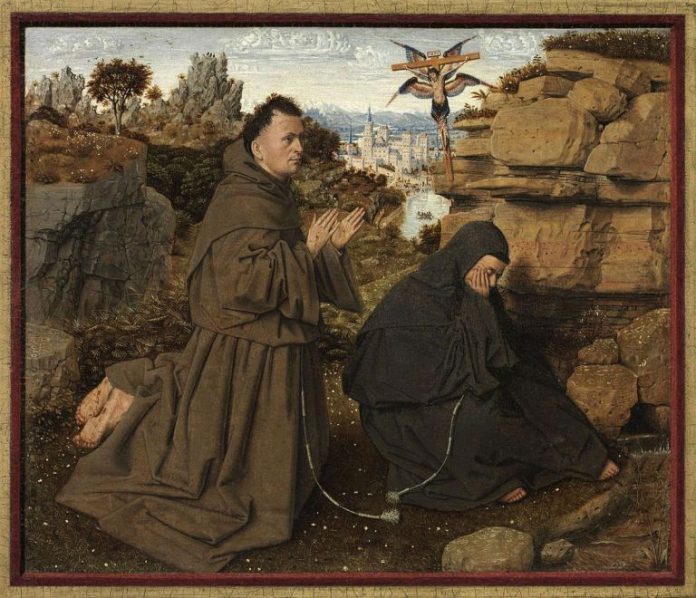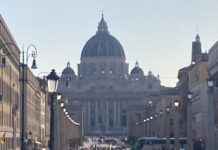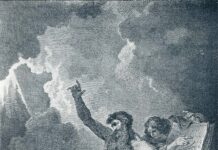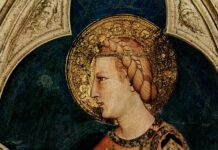On September 17th, the Franciscan Order celebrates the Feast when our Seraphic Father Francis received the Stigmata of the Crucified Christ.
The servant of God, the Italian Franciscan friar, poet and the author of three hagiographies concerning St Francis, the much famed Br Thomas of Celano (1185-1265), in The First Life of St Francis, part 2, chapter 3, when he speaks of the vision of a man having the likeness of a seraph crucified, gives us the following accurate account of what actually happened on mount Alverna:
While he dwelt in the hermitage which, from the place in which it is situate, is called Alverna, two years before he gave back his soul to Heaven, he saw in a vision of God a man like a seraph having six wings, standing over him with hands outstretched and feet joined together, fixed to a cross. Two wings were raised above his head, two were spread out for flight, and two veiled the whole body. Now, when the blessed servant of the Most High saw this, he was filled with exceeding great wonder, but he could not understand what this vision might mean. Yet he rejoiced greatly and was filled with vehement delight at the benign and gracious look wherewith he saw that he was regarded by the seraph, whose beauty far exceeded, all estimation; but the crucifixion, and the bitterness of the seraph’s suffering smote him altogether with fear. Thus he arose, so to speak, sorrowful and glad; and joy and grief alternated in him. He anxiously pondered what this vision might portend, and his spirit labored sore to come at the understanding of it. And while he continued without any clear perception of its meaning, and the strangeness of the vision was perplexing his heart, marks of nails began to appear in his hands and feet, such as he had seen a little while before in the Man crucified who had stood over him.
His hands and feet seemed pierced in the midst by nails, the heads of the nails appearing in the inner part of the hands and in the upper part of the feet, and their points over against them. Now those marks were round in the inner side of the hands and elongated on the outer side, and certain small pieces of flesh were seen like the ends of nails bent and driven back, projecting from the rest of the flesh. So also the marks of nails were imprinted in his feet, and raised above the rest of the flesh. Moreover his right side, as it had been pierced by a lance, was overlaid with a scar, and often shed forth blood, so that his tunic and drawers were many times sprinkled with the sacred blood. Alas! how few were found worthy to see the sacred wound in his side while the crucified servant of the crucified Lord was yet alive! But happy was Elias who was found worthy to see it somehow while the Saint was living; not less happy Rufino who touched it with his own hands. For once, when brother Rufino had put his hand into the most holy man’s bosom that he might scratch him, his hand (as it often chances) slipped down to Francis’ right side, and he happened to touch that precious scar, at which touch the Saint of God was not a little distressed, and, pushing the hand away, he cried to the Lord that he might forgive him (Rufino). For he concealed the stigmata most diligently from strangers, and from those about him he hid them so carefully that even the brethren at his side and his most devoted followers were for a long time unaware of them (nos. 94-95).
Amazing as this experience might have been for Francis as well as his companions it was situated in prayer. Thus, prayer was the privileged locus wherein our Seraphic Father could really let Christ transform him in Himself. On La Verna Francis’ life kept letting the Lord change his life from glory to glory simply because he was faithfully observing the holy Gospel of our Lord Jesus Christ (Regula Bullata 1:1). However, the brave Francis knew that it was essential for him to be at the Lord’s feet so as to welcome Him as his Master and Saviour. That is why he opted for long periods which he lovingly called “Lent”. These special times were for Francis’ privileged moments of intense prayer and fasting. In September 1224 Francis withdrew as usual for these exceptional periods in order to make his own the psalmist exhortation as we see in Psalm 34: O taste and see that the Lord is good! Happy is the man who takes refuge in him! (Ps 34:8). In actual fact, his receiving of the stigmata was for Francis a confirmation that his very being were now lost to be found anew in Christ Jesus for whom he gave everything so as to follow him closely.
The interpretation St Bonaventure gave of this extraordinary event in Francis’ life is very challenging. First of all he defines Francis as man of the Gospel (LM 13:1) who humbly welcomed Christ’s Cross at the outset of his conversion. From that instant Francis was completely adamant in carrying the Cross and the Passion of the Lord, thus giving example to others, with such clarity of certitude. In so doing he arrived at the summit of Gospel perfection (LM 13:10).
In his homily at the shrine of La Verna, in the feast of the Stigmatization of St Francis, on 17 September 1993, Pope St John Paul II said: 3. The stigmata, the scars of Christ’s passion on Francis’ body, were the special sign which revealed the cross that he took up every day, in the most literal sense of the word. Did not Jesus say: “If anyone wishes to come after me, he must deny himself and take up his cross daily and follow me. Whoever loses his life for my sake will save it” (Lk 9:23-24)? Francis embraced the whole truth of this paradox. The Gospel was his daily bread. He did not confine himself to reading its words, but through the expressions of the revealed text he set out to discover the One who is the Gospel itself. In fact, in Christ the divine economy is revealed in full: “losing” and “gaining” in their definitive, absolute sense. By his life Francis proclaimed and continues to proclaim today the saving word of the Gospel. It is difficult to find a saint whose message could withstand so deeply “the test of time”. Francis is the saint who is, in a certain sense, universal; through him Christ wanted to proclaim the Gospel not only to his era but to others as well, to our own age, to cultures and civilizations very different from one another. Behold: he who “lost his life” for Christ “has saved it”. He saved it in a wonderful way.
O God, who wonderfully renewed the signs of your Son’s passion in the flesh of our Holy Father Francis to inflame our hearts with the fire of your love, grant, through his intercession, that, conformed to the death of your Son, we may also share in his resurrection. Who lives and reigns with you in the unity of the Holy Spirit, one God, for ever and ever. Amen.










